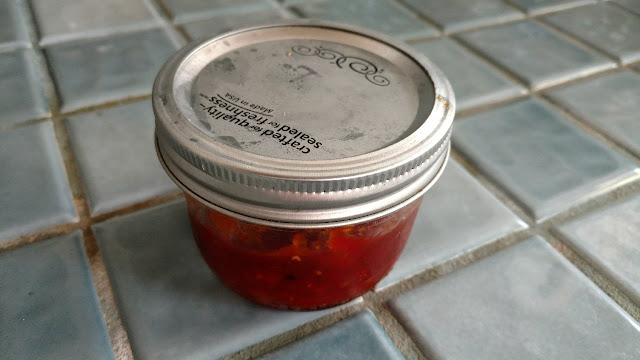
Recipe: This tomato jam is a versatile relish, on or off the sandwich
 |
| Tomato jam is a condiment that captures the taste of summer. (Photos: Debbie Arrington) |
Looking for a way to make summer last a little longer?
This recipe won’t add days to August, but it will extend the flavors of summer into fall and winter meals.
This relish is sweet, a little hot and very tomato. Served alongside chops or atop a burger, it will bring back memories of summer long after the last fresh tomato is picked.
Jamie Sandberg, my sister, has been making this tomato jam as an all-purpose relish for several years. The original recipe came from Charles and Rachel Kelsey, who own Cutty’s Sandwiches in Brookline, Mass. It is no ordinary sandwich shop. The Kelseys, both graduates of the Culinary Institute of America, met while working at America’s Test Kitchen. Their shop has been featured on the Food Network.
Cutty’s uses its tomato jam to give BLT’s a little more tomato depth before the best tomatoes of summer arrive, or after they’re gone. Delicious on a wide range of sandwiches, this relish also makes a tasty glaze for pork or chicken.
Tomato jam
Makes about 1-1/2 cups
Adapted from Cutty’s
Ingredients:
1 ½ pounds meaty tomatoes, cored and chopped
2 tablespoons fresh lemon juice
2 tablespoons cognac or brandy, optional
½ teaspoon grated fresh ginger
1 cup sugar
½ teaspoon ground cumin
¼ teaspoon crushed red pepper flakes
1 teaspoon salt
¼ teaspoon ground black pepper
Instructions:
Combine all the ingredients in a medium, heavy-bottom, non-reactive saucepan, preferably nonstick. Over medium-high heat, cook until bubbling. Reduce heat to low and simmer gently, uncovered, stirring occasionally, until thick and syrupy, about 1 hour. (As it nears proper thickness, watch carefully and stir often to prevent scorching.) Remove from heat and cool the jam to room temperature.
Store tightly covered in the refrigerator. This jam also freezes well.
Comments
0 comments have been posted.Sacramento Digs Gardening to your inbox.
Food in My Back Yard Series
April 1: Don't be fooled by these garden myths
March 25: Fertilizer tips: How to 'feed' your vegetables for healthy growth
March 18: Time to give vegetable seedlings some more space
March 11: Ways to win the fight against weeds
March 4: Potatoes from the garden
Feb. 25: Plant a fruit tree now -- for later
Feb. 18: How to squeeze more food into less space
Feb. 11: When to plant? Consider staggering your transplants
Feb. 4: Starting in seed starting
Sites We Like
Garden Checklist for week of March 30
Your garden doesn’t mind April showers. Get busy now to enjoy those future flowers.
* Get ready to swing into action in the vegetable garden. As nights warm up over 50 degrees, start setting out tomato, pepper and eggplant transplants.
* From seed, plant beans, beets, cantaloupes, carrots, corn, cucumbers, melons, pumpkins, radishes and squash. (Soak beet seeds overnight in water for better germination,)
* Plant onion sets.
* In the flower garden, plant seeds for asters, cosmos, celosia, marigolds, salvia, sunflowers and zinnias.
* Transplant petunias, zinnias, geraniums and other summer bloomers.
* Plant perennials and dahlia tubers for summer bloom.
* Transplant lettuce and cabbage seedlings.
* April is the last chance to plant citrus trees such as dwarf orange, lemon and kumquat. These trees also look good in landscaping and provide fresh fruit in winter.
* Smell orange blossoms? Feed citrus trees with a low dose of balanced fertilizer (such as 10-10-10) during bloom to help set fruit. Keep an eye out for ants.
* Apply slow-release fertilizer to the lawn.